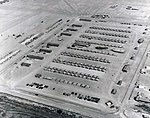Panorama Fire

The Panorama Fire was a destructive and fatal wildfire in the U.S. state of California's San Bernardino County. The fire began on November 24, 1980, and was fully contained on December 1, 1980. The fire was set by an unknown arsonist about 10:50 a.m. near Panorama Point, a county equipment depot along California State Route 18 in the San Bernardino Mountains. The fire's growth was exacerbated by strong Santa Ana winds that reached 90 miles an hour, pushing the flames into populated areas in Waterman Canyon and the city of San Bernardino. 325 structures were destroyed, including 310 homes. When the fire occurred, it was the fourth most destructive wildfire in recorded California history and the most destructive in the history of San Bernardino County. It has since passed out of the top 20 destructive wildfires statewide, and its structure toll in San Bernardino County was surpassed in 2003 by the Old Fire.The fire resulted in four fatalities: Earl F. Welty, 83, and his wife, Edith, 82, who were caught in the fire; Joseph Benjamin, 54, who collapsed while watering his roof; and Rosa Myers, 64, who suffered a heart attack while being evacuated.
Excerpt from the Wikipedia article Panorama Fire (License: CC BY-SA 3.0, Authors, Images).Panorama Fire
Rim of the World Highway,
Geographical coordinates (GPS) Address Nearby Places Show on map
Geographical coordinates (GPS)
| Latitude | Longitude |
|---|---|
| N 34.226 ° | E -117.309 ° |
Address
Rim of the World Highway 22756
92404
California, United States
Open on Google Maps



